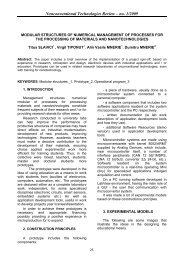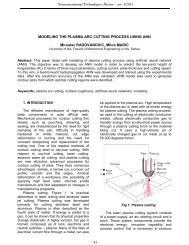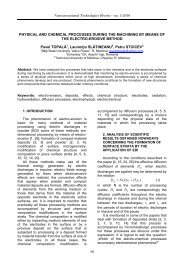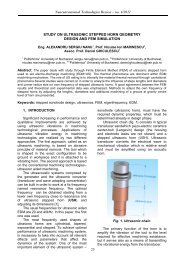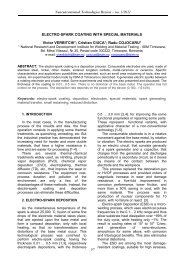ABRASIVE WATER JET CUTTING - TECHNIQUE ... - Revtn.ro
ABRASIVE WATER JET CUTTING - TECHNIQUE ... - Revtn.ro
ABRASIVE WATER JET CUTTING - TECHNIQUE ... - Revtn.ro
- No tags were found...
Create successful ePaper yourself
Turn your PDF publications into a flip-book with our unique Google optimized e-Paper software.
adial and axial directions; hence the velocitydecreases up to value v(x,r) < v 0 and the density of thecore of the jet decreases;• Disintegration zone starts f<strong>ro</strong>m the point where wehave not a core of the jet anymore.In figure 2 it is presented a water jet obtained on aexperimental water jet cutting equipment f<strong>ro</strong>m ICTCM. Thecharacteristics of this water jet are: pressure 230 MPa, nozzlediameter 0.20 mm. In this picture, it can be observed the lengthof the principal zone of the jet, and the disintegration of the jet(dimmed white layer on outside part of the jet) due to injectionand friction with the air.and a water flow of 1.2 l/min, the length of principal zone (x p )is about 90 mm.Force(N)12,51211,51110,51011125153050709011,1111211,511,1 1111 11,2 10,8Distance f<strong>ro</strong>m nozzle exit (mm)Figure 4. Variance of the water jet force withdistance f<strong>ro</strong>m nozzle exit (nozzle diameter 0.2 mm)Figure 2. View of a high pressure water jet (230 MPa)Most important f<strong>ro</strong>m application point of view, is the length ofprincipal zone (x p ), inside which are cut materials.In figure 3, the values experimentally determined arerepresented for water jet force at different pressures. Thevalues are determined using an experimentally device placedperpendicular on jet direction.1510Force (N)507,310 10,5 1190 160 175 200Pump pressure (MPa)Figure 3. Water jet forceExperimental results of a water jet force at different distancesf<strong>ro</strong>m nozzle exit are presented in Figure 4. It can be observedthat, for a nozzle diameter of 0.2 mm, a pressure of 200 MPaThe length x p can be determined int<strong>ro</strong>ducing the water jetlength quotient (k), expressed by the following formula:k = x p / d 0 (1)The authors experimentally determined values for the quotientk measuring the force of different water jets (e. g. in Figures 3and 4). Considering that at the end of principal zone the forceof the water jet decreases with 70%, the authors determined thefollowing experimental values for k quotient. Hence, forpressures in range 170 ... 230 MPa and nozzle diameters of0.15 ... 0.30 mm, the water jet length quotient can bedetermined with the following formula:k 170...230 = 250...520 (2)The velocity of a water jet, considering Bernoulli’s law, can bedetermined by the following formula:v 0= μ ⋅2Pρ( P) (3)- p 1 - pressure before the water exit the nozzle ;- v – water jet velocity at exit point f<strong>ro</strong>m the nozzle;- ρ – density of the water at the pressure p 1;- µ - quotient counting energy looses at input.In Figure 5 it is represented variation of µ quotient withpressure for carbide water nozzles determined by the authorson an experimental water jet equipment presented in nextchapter.Press.[MPa]2502001501005000,75 0,71 0,78 0,93Figure 5. Values for µ quotient (for carbide nozzles)µ41





